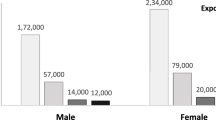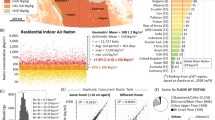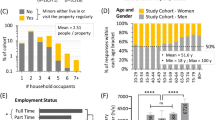Abstract
Lung cancer risk estimation in relation to residential radon exposure remains uncertain, partly as a result of imprecision in air-based retrospective radon-exposure assessment in epidemiological studies. A recently developed methodology provides estimates for past radon concentrations and involves measurement of the surface activity of a glass object that has been in a subject's dwellings through the period for exposure assessment. Such glass measurements were performed for 110 lung cancer subjects, diagnosed 1985 to 1995, and for 231 control subjects, recruited in a case–control study of residential radon and lung cancer among never-smokers in Sweden. The relative risks (with 95% confidence intervals) of lung cancer in relation to categories of surface-based average domestic radon concentration during three decades, delimited by cutpoints at 50, 80, and 140 Bq m−3, were 1.60 (0.8 to 3.4), 1.96 (0.9 to 4.2), and 2.20 (0.9 to 5.6), respectively, with average radon concentrations below 50 Bq m−3 used as reference category, and with adjustment for other risk factors. These relative risks, and the excess relative risk (ERR) of 75% (−4% to 430%) per 100 Bq m−3 obtained when using a continuous variable for surface-based average radon concentration estimates, were about twice the size of the corresponding relative risks obtained among these subjects when using air-based average radon concentration estimates. This suggests that surface-based estimates may provide a more relevant exposure proxy than air-based estimates for relating past radon exposure to lung cancer risk.
This is a preview of subscription content, access via your institution
Access options
Subscribe to this journal
Receive 6 print issues and online access
$259.00 per year
only $43.17 per issue
Buy this article
- Purchase on Springer Link
- Instant access to full article PDF
Prices may be subject to local taxes which are calculated during checkout


Similar content being viewed by others
References
Alavanja MCR Lubin JH Mahaffey JA Brownson RC . Residential radon exposure and risk of lung cancer in Missouri, Am J Public Health (1999) 89: 1042–1048
Ahrens W Merletti F . A standard tool for the analysis of occupational lung cancer in epidemiologic studies, Int J Occup Environ Health (1998) 4: 236–240
Arbetsmarknadsstyrelsen (AMS) Nordisk yrkesklassificering. Arbetsmarknadsstyrelsen, Stockholm, Sweden 1983
Bäverstam U Swedjemark GA . Where are the errors when we estimate radon exposure in retrospect? Radiat Prot Dosim (1991) 36: 107–112
Birchall A James AC . Uncertainty analysis of the effective dose per unit exposure from radon progeny and implications for ICRP risk-weighting factors, Radiat Prot Dosim (1994) 53: 133–140
Bland JM Altman DG . Measuring agreement in method comparison studies, Stat Methods Med Res (1999) 8: 135–160
Boffeta P Kogevinas M Simonato L Wilbourn J Saracci R . Current perspectives on occupational cancer, Int J Occup Environ Health (1995) 1: 315–325
Breslow NE Day NE . Statistical methods in cancer research, Vol. 1, The analysis of case–control studies. International Agency for Research on Cancer, Lyon, France 1980
Breslow NE Storer BE . General relative risk functions for case–control studies, Am J Epidemiol (1985) 122: 149–162
Cornelis J Landsheere C Van Trier A Vanmarke H Poffijn A . Experiments on glass-adsorbed polonium-210. International Journal of Radiation Applications & Instrumentation–Part A, Appl Radiat Isot (1992) 43 (1–2): 127–138
Cross FT . Residential radon risk from the perspective of experimental animal studies, Am J Epidemiol (1994) 140: 333–339
Darby S Whitley E Silcocks P Thakrar B Green M Lomas P Miles J Reeves G Fearn T Doll R . Risk of lung cancer associated with residential radon exposure in south-west England: a case–control study, Br J Cancer (1998) 78: 394–408
Falk R Almrén K Östergren I . Experience from retrospective radon exposure estimations for individuals in a radon-epidemiological study using solid state nuclear track detectors, Sci Total Environ (2001) 272: 61–66
Falk R Mellander H Nyblom L Östergren I . Retrospective assessment of radon exposure by measurement of 210Pu implanted in surfaces using an alpha track detector technique, Environ Int (1996) 22 (Suppl. 1): 857–861
Gustavsson P Jakobsson R Nyberg F Pershagen G Järup L Schéele P . Occupational exposure and lung cancer risk — a population-based case-referent study in Sweden, Am J Epidemiol (2000) 152: 32–40
International Agency for Research on Cancer (IARC). IARC Monographs on the Evaluation of Carcinogenic Risks to Humans, Vol. 43, Man-made Mineral Fibres and Radon. IARC, Lyon 1988
International Commission on Radiological Protection (ICRP). Lung cancer risk from indoor exposures to radon daughters, Ann ICRP (1987) 17: 1–60
International Commission on Radiological Protection (ICRP). Protection against radon-222 at home and at work, Ann ICRP (1993) 23: 1–45
Knutson EO . Modeling indoor concentrations of radon's decay products. In: Nazaroof W W, and Nero Jr. A V (Eds). Radon and Its Decay Products in Indoor Air. Wiley, New York (1988) 161–202
Lagarde F Axelsson G Damber L Mellander H Nyberg F Pershagen G . Residential radon and lung cancer among never smokers in Sweden, Epidemiology (2001) 12: 396–404
Lagarde F Pershagen G Åkerblom G Axelson O Bäverstam U Damber L Enflo A Svartengren M Swedjemark GA . Residential radon and lung cancer in Sweden: risk analysis accounting for imprecision in the exposure assessment, Health Phys (1997) 72: 269–276
Lively RS Ney EP . Surface radioactivity resulting from the deposition of 222Rn daughter products, Heath Phys (1987) 52: 411–415
Lubin JH . Models for the analysis of radon-exposed populations, Yale J Biol Med (1988) 61: 195–214
Lubin JH Boice JD Jr. Lung cancer risk from residential radon: meta-analysis of eight epidemiologic studies, J Natl Cancer Inst (1997) 89: 49–57
Lubin JD Boice JH Jr. Samet JM . Errors in exposure assessment, statistical power and the interpretation of residential radon studies, Radiat Res (1995) 144: 329–341
Mahaffey JA Parkhurst MA James AC Cross FT Alavanja MCR Boice JD Ezrine S Henderson P Brownson RC . Estimating past exposure to indoor radon from household glass, Health Phys (1993) 64: 381–391
Mellander H Enflo A . The alpha track method used in the Swedish radon epidemiology study, Radiat Prot Dosim (1992) 45: 65–71
National Research Council (NRC). Comparative Dosimetry of Radon in Mines and Homes. National Academy Press, Washington, DC 1991
National Research Council (NRC) Committee on Biological Effects of Ionizing Radiation (BEIR VI). Health Effects of Exposure to Radon. National Academy Press, Washington, DC 1999
Nyberg F Agrenius V Svartengren K Svensson C Pershagen G . Environmental tobacco smoke and lung cancer in nonsmokers: does time since exposure play a role?, Epidemiology (1998) 9: 301–308
Nyberg F Gustavsson P Järup L Bellander T Berglind N Jakobsson R Pershagen G . Urban air pollution and lung cancer in Stockholm, Epidemiology (2000) 11: 487–495
Pershagen G Åkerblom G Axelson O Clavensjö B Damber L Desai G Enflo A Lagarde F Mellander H Svartengren M Swedjemark GA . Residential radon exposure and lung cancer in Sweden, N Engl J Med (1994) 330: 159–164
Porstendörfer J . Properties and behaviour of radon and thoron and their decay products in the air, J Aerosol Sci (1994) 25: 219–263
Porstendörfer J Reineking A . Radon: characteristics in air and dose conversion factors, Health Phys (1999) 76: 300–305
Preston DL Lubin JH Pierce DA EPICURE risk regression and data analysis software. HiroSoft International, Seattle, WA 1990
Samuelsson C . Retrospective determination of radon in houses, Nature (1988) 334: 338–340
StataCorp Stata Statistical Software: Release 7.0. Stata, College Station, TX 2001
Steck DJ . Spatial and temporal indoor radon variations, Health Phys (1992) 62: 351–355
Thomas DC . General relative-risk models for survival time and matched case–control analysis, Biometrics (1981) 37: 673–686
Walsh C McLaughlin JP . Correlation of 210Po implanted in glass with radon gas exposure: sensitivity analysis of critical parameters using a Monte-Carlo approach, Sci Total Environ (2001) 272: 195–202
Weinberg CR Moledor ES Umbach DM Sandler DP . Imputation for exposure histories with gaps, under an excess relative risk model, Epidemiology (1996) 7: 490–497
Acknowledgements
This study was supported by grants from the Swedish Cancer Society and the European Commission. We thank the staff of the municipal public health boards for assistance with the performance of radon measurements, and Hillevi and Giertz and Östergren for the preparation and readings of air and surface detectors, respectively.
Author information
Authors and Affiliations
Corresponding author
Appendices
Appendix A
Formula for estimating the average radon concentration (Bq m−3) to which the glass object has been exposed between acquisition until the end of the relevant observation period for radon exposure (i.e., with adjustment for build-up and decay past that date and until measurement of the current 210Po activity in the glass surface), denoted C below

where S=measured surface activity (Bq m−2) for the object exposed during m years; m=age of the object, in years; a=radon concentration in current dwelling (Bq m−3); and n=number of years past the end of the relevant observation period for radon exposure during which the object has been placed in the current dwelling.
Comments
1. The constant 42 is a calibration factor indicating that an object exposed during 20 years in an environment where the radon concentration is 42 Bq m−3 of radon is expected to show a 210Po surface activity of 1 Bq m−2. This value may be modified to account for factors affecting the plate-out rate of radon daughters on the surface of the glass.
2. The constant 0.05136 is the surface activity at equilibrium for a constant radon concentration of 1 Bq m−3.
3. The structure of the formula above is as follows:

where
(i) the component s represents the current surface activity from exposure during the non relevant time period (which is subtracted from the currently measured activity S);
(ii) the ratio is thus the surface activity that would have been observed at the end of the relevant time period (the denominator adjusting for decay since the date);
(iii) norm20 is a component included to transform the estimated activity into the activity that would have been measured if the object had been building-up activity on its surface during 20 years rather than for the number of years assessed (normalization is necessary because objects have been building up activity for different time lengths, but the choice of a length of 20 years for normalization is inconsequential and may be changed, granted that the present calibration constant of 42 is also modified).
Appendix B
Formula for estimating the radon concentration in Bq m−3 to which a subject has been exposed on average during the observation period for radon exposure, with imputation for the unknown average radon concentration during the time period not covered by the glass object, denoted E below

where C, m are as defined in A.1 above; L=duration in years of the relevant observation period for radon exposure; p=the duration in years of the time period between the end of the relevant observation period for radon exposure and measurement of the 210Po activity in the glass surface; μ=study-specific mean of the values for C among control subjects, or more generally any appropriate value for imputation that is not expected to bias risk estimation.
Appendix C
Formula for the modified form of E where years imputed are weighted in order to account for decay, as occurred naturally for measured years
For the radon concentration corresponding to each year of the relevant observation period, indexed by i to indicate single years of exposure ending i years prior to the end of the observation period, we attribute the weights Wi defined as:

where L is defined as in A.2.
The modified form of E is then computed as:

where C, p and μ are defined as in A.2.
Appendix D
Formula for the modified form of the air-based average radon concentration estimate where individual years are weighted in order to account for decay, as occur naturally for glass monitors

where L is defined as in A.2, and Wi as in A.3; Ai=radon concentration (Bq m−3) for year ending i years prior to the end of the observation period, based on measured concentrations in dwellings occupied the corresponding years, or if not measured, imputed using the study-specific average of the measured dwellings among control subjects.
Rights and permissions
About this article
Cite this article
LAGARDE, F., FALK, R., ALMRÉN, K. et al. Glass-based radon-exposure assessment and lung cancer risk. J Expo Sci Environ Epidemiol 12, 344–354 (2002). https://doi.org/10.1038/sj.jea.7500236
Received:
Published:
Issue Date:
DOI: https://doi.org/10.1038/sj.jea.7500236
Keywords
This article is cited by
-
Meta-analysis of case–control studies on the relationship between lung cancer and indoor radon exposure
Radiation and Environmental Biophysics (2019)
-
Two dimensions of measurement error: Classical and Berkson error in residential radon exposure assessment
Journal of Exposure Science & Environmental Epidemiology (2004)



